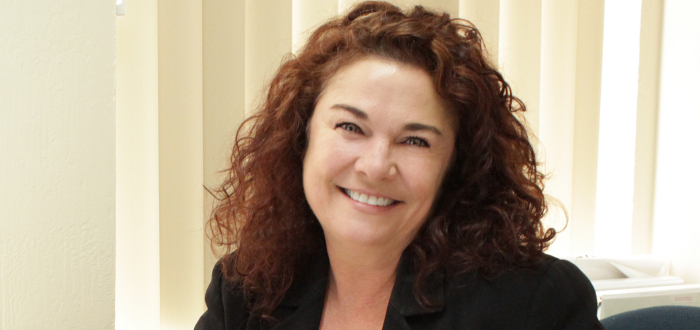As a single mom, serial entrepreneur and former Napster CEO, Eileen Richardson needed a break. She took a sabbatical eight years ago to spend time with her high school-aged kids and volunteer at a local food pantry. The respite didn’t last for long.
When a Palo Alto business district started talking about how to lessen panhandling and litter outside their storefronts, the group broached the idea of taking both problems to cancel each other out: offer homeless panhandlers jobs cleaning up the neighborhood. They tapped Richardson for the project, asking her to lead the effort and come up with a system to put the plan to work.
The project evolved into Downtown Streets Team, a nationally lauded nonprofit that’s given the down-and-out a hand up through paid work and communities a model for solving homelessness. Today, the organization has taken root in cities across Silicon Valley and, as of last year, in the East Bay.
By offering work, employment training, counseling, housing help and job placement—among so many other services—Downtown Streets Team has changed hundreds of lives. Richardson believes the nonprofit’s approach can effectively end homelessness in five years. We caught up with her to find out what she’s up to lately.
SanJose.com: Napster head to nonprofit director is a pretty dramatic switch. Can you tell us a little more about how you made the transition from high-powered CEO to charity executive?
Richardson: I was in venture capital for a decade and CEO of two high tech companies before I took that break. I was also, this entire time, a single mom. I’ve been a single mom for 25 years. Having such a demanding career and being a single mom kept me very busy. So when I was done with my second CEO gig and my kids were in high school I decided to take some time off to spend time with my family. One day, I was walking downtown after breakfast in Palo Alto and passed by the food pantry. The idea struck me then that I wanted to volunteer, even though my son was going, “Don’t do it mom,” because he knew I would get completely absorbed in the project. Before I knew it I was the assistant manager at the Urban Ministries Downtown Food Closet. I thought I’d take off about a year or so, but it didn’t turn out that way. I’m really happy about that.
Why did you choose to focus on homelessness, specifically?
I had always cared about homeless issues. Where I grew up in upstate New York, there was a place called the Bowery and I’d see homeless men and women and think, “I really want to help them.” But what do you do? What everyone becomes conditioned to do: keep walking, look down. I’d always had a piece of me that wanted to help. It’s an issue that’s always bothered me, something I’ve thought about a lot over the years. There’s not a big difference between them and us. Maybe it’s a little bit of bad luck or a lack of family support or something like that that pushed them to that situation.
Downtown Streets Team started in Palo Alto in 2006 and branched out from there. How has it grown since then?
There was this idea floating around about the streets team years ago. People were talking about having the homeless cleanup the streets in exchange for Safeway vouchers. The downtown Palo Alto Business Improvement District originally brought up the idea. They had done a survey with the business owners asking what their biggest issues were and they said, overwhelmingly they were cleanliness and panhandling. So the thinking was, why not have men and women we consider part of the problem be part of the solution? The whole project started with that thought, four team members and a $50,000 budget. Today we have 35 employees, 130 team members in the county, 400 graduates and a budget of $4 million. Now we’re in seven communities across the country. Now, we want to go national. We do have some traction, which is quite exciting. All of our growth comes from word of mouth.
Are there any other programs like this?
Not that I know of. There are “programs,” but we really never want to call ourselves a “program” because that implies curfews and drug tests and other restrictions. We do something completely different. We say, let’s get them jobs first. We tell them that all we expect is for them to come sober, work for four hours, be at least 18 years old and then try this again the next day. We have weekly meetings where there’s lots of clapping and hugs and certificates and people encouraging each other to stay on track.
Why does this model work so well?
We get asked that a lot. What it comes down to: it’s because the streets team staff keeps 90 percent of its promises. Maybe that doesn’t’ sound super impressive, like 100 percent, but we really try to not get peoples’ hopes up. There are people out there handing out socks and promising housing and healing and when that doesn’t’ happen, [the homeless] lose hope after a while. We tried to stay away from that, to stay true to our word. Another thing is the positivity. People can come back to the program as many times as they want. There’s no failure rate. There’s completely no judgment whatsoever. The third thing is that we’re in this together. I have scrubbed toilets by their side. I have been on the streets sweeping with my team members. I think that’s really important, that everybody understands that we’re all one team together.
What are some common misperceptions people have about homelessness?
There was a survey done in 2006 before the opportunity center opened. People had asked what’s the worst thing about being homeless. You’d think the answer was, “I’m cold” or “I’m hungry,” but resoundingly it was, “The way people look down on me.” It’s so terrible to think that in this country poverty and homelessness are tied to laziness. There’s this narrative that if you worked hard enough you wouldn’t be homeless. Can you imagine what that would do to your self-confidence? As a society, it’s so ingrained that your occupation is part of your identity. When they meet you, people say, “What’s your name?” and “What do you do for a living?” And when you’re homeless, you lose that claim to a socially acceptable identity. Then day after day, you get filthier because it’s harder to find a shower. You become more isolated. You fall off the grid. If people could do just one thing to help, just smile and say, “How are you?”
What would you like to see for the future of this program?
Right now, we have inbound interest from a very large city north of us, so there’s going to be more expansion. There’s also some interest in Santa Cruz, in Costa Mesa and we get inbound calls from all over the country all the time. But right now we’re really focused on the nine counties in the Bay Area. We’ve been in San Rafael since August and we’re working with three other cities in Marin County. It’s great. Our growth is a testimony to how people just want to not be judged, to feel like they’re part of a team and to be given a pathway to work hard and make their life better.
Silicon Valley has become, over the past few years, the face of homelessness and income inequality. Do you think the coexisting culture of tech and innovation has somewhat of a responsibility to address this problem?
It’s incredible. We’ve been on TV in Germany and in Holland and have had calls from Japan, Italy and Paris, all asking about this crisis. It’s internationally known that we have this inequity and it’s a pity. So we’re really trying to see if we can end this for good. All we need is $500 million to end homelessness in Silicon Valley. That would pay for housing costs for the homeless population in Santa Clara County. While I don’t think that just because you’re rich you have any responsibility to do anything, I do believe that once people are aware that this is a pressing social issue we should band together to come up with a solution.
How can people help you help the homeless?
There’s this huge day coming up called Silicon Valley Gives, so I’m very hopeful that Silicon Valley will be giving.

 Psycho Donut's Offers 'Toe Jam' Doughnut, Benefit Party for Bigfoot Discovery Museum
Psycho Donut's Offers 'Toe Jam' Doughnut, Benefit Party for Bigfoot Discovery Museum  Review: Chocatoo Packs Cornucopia of Candy into Little Package
Review: Chocatoo Packs Cornucopia of Candy into Little Package 

